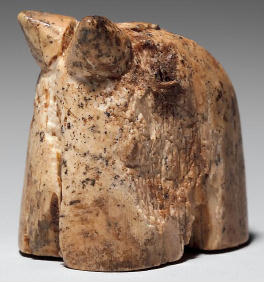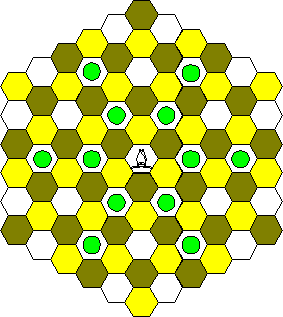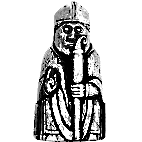Piececlopedia: Bishop
Historical notes

In the end of the middle ages, the slow Alfil was replaced in the game of chess by the Bishop. This was part of an overall reform of the rules of Chess, making the game much faster.
The Bishop has its roots in an Indian piece called a Hasty or Gaja, which were both Indian words for elephant. Persians called it Pil, the Persian word for elephant, and the Arabs modified this to Fil. At some point, the Arabic definite article got prepended, giving the name Alfil, meaning the elephant. When the names of Fil and Alfil reached Europe, they were meaningless to the Europeans. In trying to find some meaning in the name, Europeans often used similar sounding words in their own languages. Italians started calling it Alfiere, which meant flag-bearer. The French began calling it delfino, which suggested "dauphin," the French crown prince. The French also played on the similarity in sound between fil and the French word fol, which is related to the English word fool. This led to the current French name for the piece, which is fou, meaning jester or fool.
It should be noted that Murray rejects this etymology of the name fou, but his reasons don't stand up well. His main reason is that the French knew the piece only as an Alfil, not as a Fil. In contrast, Davidson says that the French did know of it as a Fil. Even if Murray is right about the name of Fil not being current in France, he overlooks some important facts. The French definite articles are very similar to the Arabic definite article. Its feminine form, la, is just al spelled backwards. Being neighbors with Spain, the French would already be familiar with another definite article that had the backwards spelling of one of theirs. Le, the French masculine definite article, is just el spelled backwards. So it wouldn't be out of the question for the French to interpret the first syllable of Alfil as a definite article. Besides this, the French normally contract the definite article before words beginning with a vowal. So, le Alfil could become l'Alfil. This sounds almost like La Fil. Just drop the second l, and it may seem to a French speaker that the piece is a Fil, not an Alfil. So it seems, contrary to Murray, that the current French name of the piece does have its roots in the Arabic name.

Instead of playing on the piece's Arabic name, the English gave it a new name that seemed to fit the design of the piece used at the time. The Alfil piece had two projections at the top, which were supposed to be elephant tusks. The English interpreted this as a Bishop's mitre and began to call the piece a Bishop, which fit in with the English idea that Chess was a court game rather than a war game. Icelandic, which calls it a biskup, and Portugese (bispo) are other languages whose name for this piece means Bishop. Germans gave the piece entirely new names, such as der Alte, which means sage, and the current name, Laufer, which means courier or runner. This name seems to have its roots in Courier Chess, which included both the Alfil and the modern Bishop. The Dutch call it Loper, which means the same as Laufer.
Shogi has an identically moving piece of independent origin. It is commonly known to English speakers as a Bishop, though, as reported by Murray, its Japanese name literally means angle-going.
Because the Bishop is one of the regular Chess pieces, it has been used in countless Chess variants. In Yáng Qí, a recent Xiangqi variant by Fergus Duniho, the Bishop was renamed as Sage, Sheng in Chinese, so that it could be represented by a single Chinese character. The choice of this name was guided by the German name of der Alte. Examples of the Sheng piece are included among the alternate piece images shown further below.
Movement
The Bishop moves an arbitrary number of spaces in any diagonal direction. It may not pass over occupied spaces, and it ends its move by occupying an empty space or by capturing an enemy piece.
Movement Diagrams
|
|

|
Vocabulary: Diagonal
A Bishop moves diagonally. Diagonal movement passes through the corners of spaces, connecting spaces of the same color on a suitably checkered board. Diagonally adjacent squares share a common corner but have no sides in common. Diagonally adjacent hexagons share no sides or corners in common and are connected by a line that touches a corner of each space.
Alternate Images
Click on an image to view the full piece set it belongs to.
 |
||||
 |
 |
 |
References
Davidson, Henry A. A Short History of Chess, 1949.
Murray, H. J. R. A History of Chess, 1913.
This is an item in the Piececlopedia: an overview of different (fairy) chess pieces.
Written by Fergus Duniho and Hans Bodlaender. Diagram by Ben Good. Information on Portugese name of Bishop by Nuno Cruz.
WWW page created: September 9, 1998. Last modified: December 15, 2001.
